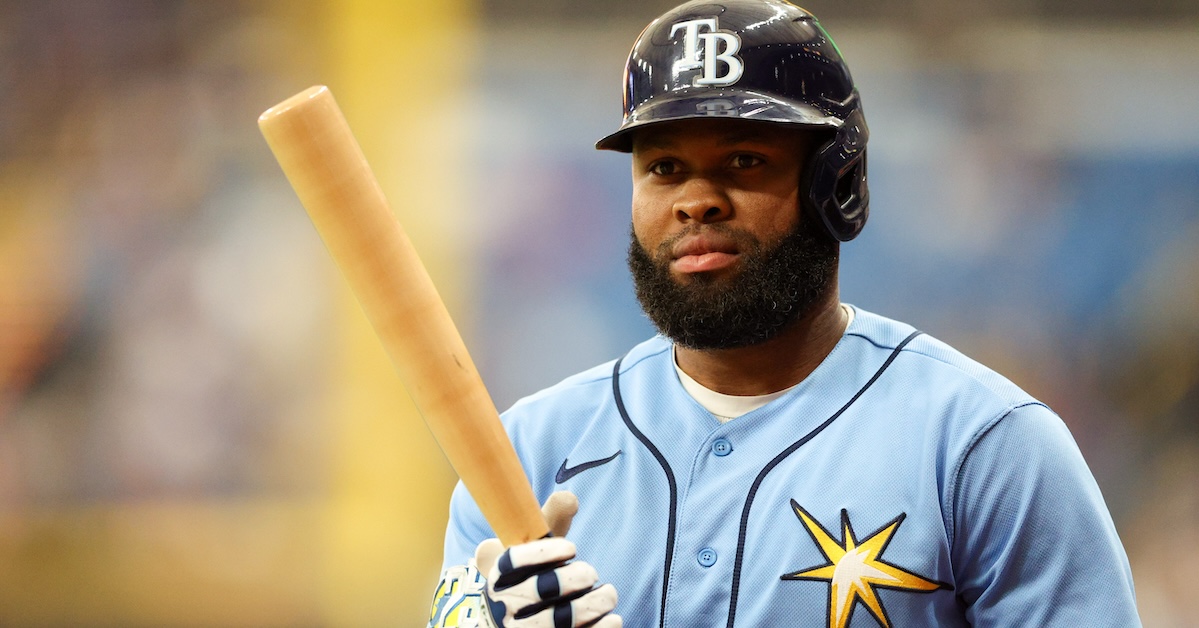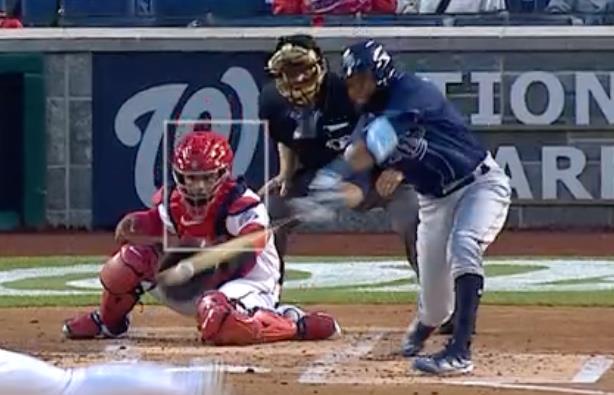
Nathan Ray Seebeck-USA TODAY Sports
This was supposed to be a simple one. To ease my way into 2024, I dipped into the bag of fun ideas that I’d been saving for the offseason. Once we get past the All-Star break, there’s so much serious baseball being played that I try not to pitch too many frivolous stories. I don’t always succeed, but I try. As a result, when the season ends, the Notes app on my phone is full of hastily-typed fragments:
- The noise Andrew Vazquez [sic] makes when he pitches
- The Palmeiro Award – goes to the least deserving GG winner each year
- Players tearing their pants when they slide. Andrew Benintendi 8/15/23
- Where do pop-ups come from?
- Pitchers who make the most fun noises
The idea for this article was called Weakest hit balls of the year, and it seemed pretty straightforward. Take a look at the batted balls with the lowest exit velocity and have some fun writing about nubbers, squibbers, and dribblers. As it turns out, that’s actually a slightly tricky assignment.
First, there are plenty of plays to weed out. Statcast sometimes struggles to track balls hit directly into the ground. It must be hard to get a good reading on a ball that only travels a foot or two before hitting the ground and changing direction. A lot of those topped balls have no Statcast data whatsoever, but for some, Statcast records the speed and angle not of the ball off the bat, but of the ball bouncing off the dirt.
Those misclassifications usually get cleaned up, but just for fun, here’s the ball that is currently classified as the weakest non-bunt of the 2023 season. It came — very slowly — off the bat of Adley Rutschman on July 29. Fooled by an Ian Hamilton sinker, the Baltimore backstop tried to check his swing but ended up catching the ball ever so gently with the tip of his bat. He sent it straight into the ground behind home plate, and Statcast clocked the resultant bounce at 9.8 mph with a launch angle of 61 degrees.
In order to make sure that I didn’t miss any of the actual weakest-hit balls of 2023, I watched every single misclassified or unclassified ball that ended up being fielded by the catcher or pitcher. It turns out that if you watch enough balls get chopped directly into the ground, you start to take a perverse joy in noticing the exact moment when the batter realizes that the ball is going to end up in fair territory. You can see it clear as day, as if a little thought bubble appears next to their head that just says, “RUN!!!”
Rutschman’s dribbler has a whole narrative arc: He’s swinging because life is short and sometimes you just have to go for it. He’s trying desperately to stop his swing because it turns out that life is actually quite complicated. He’s just standing there staring at the ball and willing it not to bounce forward. He’s running to first because apparently telekinesis is not one of the five tools. Just after he reaches the bag, he’s throwing his head back in exasperation because life is pain.
The other plays that need to be weeded out are bunts, but again, there’s something deeply rewarding about watching the very weakest bunts of the season. While it may not qualify a player for the title of softest-hit ball of the year, being the absolute best at deadening the baseball is a skill that deserves celebrating. In 2023, the average bunt came off the bat at a surprisingly fast 34.1 mph.
Here’s the slowest bunt of the year, in which Washington’s Alex Call absorbs enough kinetic energy to turn an 82.6 mph slider from Kodai Senga into an 8.6 mph sacrifice. That’s impressively slow, and Call would prove it wasn’t a fluke by bunting a ball at 8.9 mph, the third-softest bunt of the season, just a few weeks later. If you’re a coach who’s ever instructed a young player that the proper way to bunt is to catch the ball with the bat, this might just bring tears to your eyes.
Watching this clip makes you wonder whether Call really could catch the ball with his bat. Not only does he match the speed of the pitch perfectly, he matches the trajectory of its break, popping it upward ever so slightly. It is a thing of beauty. However, it is not a particularly great bunt. It is also a free out for the Mets and a bad idea. Runner Corey Dickerson will never advance past second base. Don’t bunt, kids.
Now that we’ve weeded out the non-qualifiers, let’s take one final detour to consider how the weakest-hit balls come about. As you read the next few paragraphs, keep in mind this is just a thought experiment, and it should not be mistaken for knowledge about physics. Feel free to correct my misconceptions in the comments, but Dr. Alan Nathan, if you happen to be reading this, please be gentle.
We need to think about angles. We’re not just looking for the softest-hit ball. The softest-hit ball of the 2023 season was probably a pitch that everyone believed to be a whiff. The barest nanometer of leather or stitching grazed the wood of the bat so faintly that the collision made no sound and had no detectable impact on the speed or direction of the pitch. Not even the batter or the catcher realized that it happened at all. I imagine it happens all the time.
While that may be the softest you can possibly hit a ball, it won’t produce the lowest exit velocity and it won’t send the ball into fair territory. We’re looking for the fair ball with the lowest exit velocity, which changes the calculus. In theory, the weakest fair ball would be one in which the bat moves backward at the perfect speed to absorb all of the momentum of the ball, leaving it to fall straight downward. The exit velocity of such a pitch would essentially just be the speed at which gravity pulled the ball toward the ground.
That’s how a bunt works, especially if you’re Alex Call. But we’re looking for swings, and the bat is moving forward during a swing. That being the case, we need two things. First, we need a slow bat. We’re on the hunt for an emergency hack, a check swing, or a batter who got completely fooled. The result needs to be a swing with no power behind it.
Second, we need poor contact. Think about when a batter hits the ball flush. The ball and bat have tremendous kinetic energy, and when the batter makes perfect contact, that energy is transferred into the ball very efficiently. Now think about when a hitter gets jammed. Instead of going into the ball, a lot of that energy travels down through the bat and into the hands. Maybe it breaks the bat as well. Inefficient contact allows us to strike a balance: the bat absorbs as much of the ball’s energy as possible while transferring as little of its own energy into the ball as possible. To get the weakest batted ball possible, we need the bat to be traveling at an extremely inefficient angle and to make contact at an extremely inefficient spot, like the handle or the end. Put those two factors together, and we’re looking for ugly swings and weird contact.
At long last, that brings us to the actual, honest-to-goodness, weakest batted ball of 2023. It occurred just a few days into the season, on April 3. Readers of FanGraphs, I give you Manuel Margot at 19.1 mph.
All of the ingredients are there. Margot is completely fooled by a 2-2 sweeper from Trevor Williams. In order to both reach the ball and stay back long enough to actually make contact, he has to abandon his lower half and throw his hands at the ball. This is not exactly the body positioning that a hitting coach is looking for at contact, which means it’s great for our purposes. He’s not bringing any power into the swing.

As for the weirdness, Margot is so far in front that he catches the ball with the cupped end of his bat. That both deadens the ball and imparts an insane amount of spin. And that weird contact brings even more weirdness into the play. It is an absolute delight. It’s mayhem. The ball hugs the first baseline for 15 feet before suddenly veering in toward the mound. Williams, trying and failing to calculate an intercept course for the ball’s drunken path, collapses. He ends up crawling to the ball and then — I don’t even know what the word is — the action with which he sends the ball toward is some unwieldy combination of a shovel pass and a wish.
For all that, the ball very nearly beats Margot to the bag. However, that turns out not to matter, because the weirdness continues. Dominic Smith not only fails to catch Williams’ prayer, he loses his glove in the process. Margot takes off for second. Josh Lowe keeps on running to third (and ends up scoring the game’s winning run on the very next play). Everyone else does something with their hands. The first base coach directs Margot toward second base. The second baseman points at the baseball before realizing that he’s the one who has to go and retrieve it. Smith turns his palms skyward, presumably to ask the only sensible question in this situation: What the hell is happening?
As it turns out, the weakest batted ball of the year almost didn’t happen at all. The bedlam occurred on the eighth pitch of Margot’s at-bat. Very much against the spirit of this entire endeavor, he tried to bunt the first two pitches, but he fouled them both off very hard. He then battled back to a 2-2 count, fouling off three four-seamers up and laying off two sliders in the dirt before chasing the third to such mirthful effect. Had either of Margot’s attempts succeeded, none of this weird contact and weirder baseball ever would have happened. As always, the lesson is to stop bunting. Well, unless you can do it really softly.
Source
https://blogs.fangraphs.com/dribbler-deep-dive-the-weakest-hit-ball-of-2023/
 Backyard GrillingWeekend WarriorsAdvice from DadBeard GroomingTV Shows for Guys4x4 Off-Road CarsMens FashionSports NewsAncient Archeology World NewsPrivacy PolicyTerms And Conditions
Backyard GrillingWeekend WarriorsAdvice from DadBeard GroomingTV Shows for Guys4x4 Off-Road CarsMens FashionSports NewsAncient Archeology World NewsPrivacy PolicyTerms And Conditions
